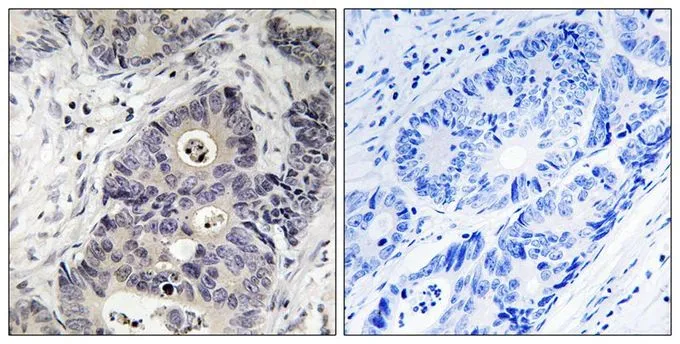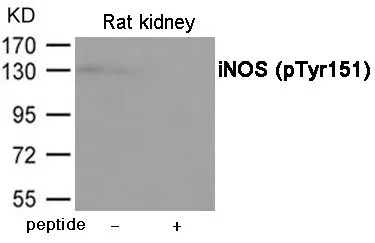![ELISA analysis of antigen using GTX60599 iNOS antibody [4E5]. Black : Control antigen 100ng Purple : Antigen 10ng Blue : Antigen 50ng Red : Antigen 100ng ELISA analysis of antigen using GTX60599 iNOS antibody [4E5]. Black : Control antigen 100ng Purple : Antigen 10ng Blue : Antigen 50ng Red : Antigen 100ng](https://www.genetex.com/upload/website/prouct_img/normal/GTX60599/GTX60599_20170912_ELISA_w_23061123_251.webp)
ELISA analysis of antigen using GTX60599 iNOS antibody [4E5]. Black : Control antigen 100ng Purple : Antigen 10ng Blue : Antigen 50ng Red : Antigen 100ng
iNOS antibody [4E5]
GTX60599
ApplicationsFlow Cytometry, Western Blot, ELISA, ImmunoHistoChemistry, ImmunoHistoChemistry Frozen, ImmunoHistoChemistry Paraffin
Product group Antibodies
TargetNOS2
Overview
- SupplierGeneTex
- Product NameiNOS antibody [4E5]
- Delivery Days Customer9
- Application Supplier NoteWB: 1/500 - 1/2000. IHC-P: 1/200 - 1/1000. FACS: 1/200 - 1/400. ELISA: 1/10000. *Optimal dilutions/concentrations should be determined by the researcher.Not tested in other applications.
- ApplicationsFlow Cytometry, Western Blot, ELISA, ImmunoHistoChemistry, ImmunoHistoChemistry Frozen, ImmunoHistoChemistry Paraffin
- CertificationResearch Use Only
- ClonalityMonoclonal
- Concentration1 mg/ml
- ConjugateUnconjugated
- Gene ID4843
- Target nameNOS2
- Target descriptionnitric oxide synthase 2
- Target synonymshepatocyte NOS; HEP-NOS; inducible NO synthase; inducible NOS; INOS; nitric oxide synthase 2, inducible; nitric oxide synthase 2A (inducible, hepatocytes); nitric oxide synthase, inducible; nitric oxide synthase, macrophage; NOS; NOS, type II; NOS2A; peptidyl-cysteine S-nitrosylase NOS2
- HostMouse
- IsotypeIgG1
- Protein IDP35228
- Protein NameNitric oxide synthase, inducible
- Scientific DescriptionNitric oxide is a reactive free radical which acts as a biologic mediator in several processes, including neurotransmission and antimicrobial and antitumoral activities. This gene encodes a nitric oxide synthase which is expressed in liver and is inducible by a combination of lipopolysaccharide and certain cytokines. Three related pseudogenes are located within the Smith-Magenis syndrome region on chromosome 17. [provided by RefSeq, Jul 2008]
- Storage Instruction-20°C or -80°C,2°C to 8°C
- UNSPSC12352203
References
- Chromofungin, a chromogranin A-derived peptide, protects against sepsis-induced acute lung injury by inhibiting LBP/TLR4-dependent inflammatory signaling.Read more
- Therapeutic effect of induced pluripotent stem cell -derived extracellular vesicles in an in vitro and in vivo osteoarthritis model.Read more
- Lupeol reduces M1 macrophage polarization to attenuate immunologic dissonance and fatty acid deposition in rats with diet-induced metabolic syndrome. Li J et al., 2021 Oct, Ann Transl MedRead more
- Short-Chain Fatty Acids Improve Poststroke Recovery via Immunological Mechanisms. Sadler R et al., 2020 Jan 29, J NeurosciRead more
- Mesenchymal stem cells attenuate sepsis-induced liver injury via inhibiting M1 polarization of Kupffer cells. Liang X et al., 2019 Feb, Mol Cell BiochemRead more
- Inhibition of chronic prostate inflammation by hyaluronic acid through an immortalized human prostate stromal cell line model. Liu MC et al., 2017, PLoS OneRead more
- Effect of magnesium sulfate on renal ischemia-reperfusion injury in streptozotocin-induced diabetic rats. Akan M et al., 2016 Apr, Eur Rev Med Pharmacol SciRead more

![FACS analysis of MCF-7 cells using GTX60599 iNOS antibody [4E5]. Green : iNOS Red : negative control FACS analysis of MCF-7 cells using GTX60599 iNOS antibody [4E5]. Green : iNOS Red : negative control](https://www.genetex.com/upload/website/prouct_img/normal/GTX60599/GTX60599_20170912_FACS_w_23061123_802.webp)
![IHC-P analysis of liver cancer tissue using GTX60599 iNOS antibody [4E5]. IHC-P analysis of liver cancer tissue using GTX60599 iNOS antibody [4E5].](https://www.genetex.com/upload/website/prouct_img/normal/GTX60599/GTX60599_20170912_IHC-P_1_w_23061123_136.webp)
![IHC-P analysis of breast cancer tissue using GTX60599 iNOS antibody [4E5]. IHC-P analysis of breast cancer tissue using GTX60599 iNOS antibody [4E5].](https://www.genetex.com/upload/website/prouct_img/normal/GTX60599/GTX60599_20170912_IHC-P_w_23061123_871.webp)
![WB analysis of human iNOS (AA: 997-1058) recombinant protein using GTX60599 iNOS antibody [4E5]. WB analysis of human iNOS (AA: 997-1058) recombinant protein using GTX60599 iNOS antibody [4E5].](https://www.genetex.com/upload/website/prouct_img/normal/GTX60599/GTX60599_20170912_WB_w_23061123_160.webp)





